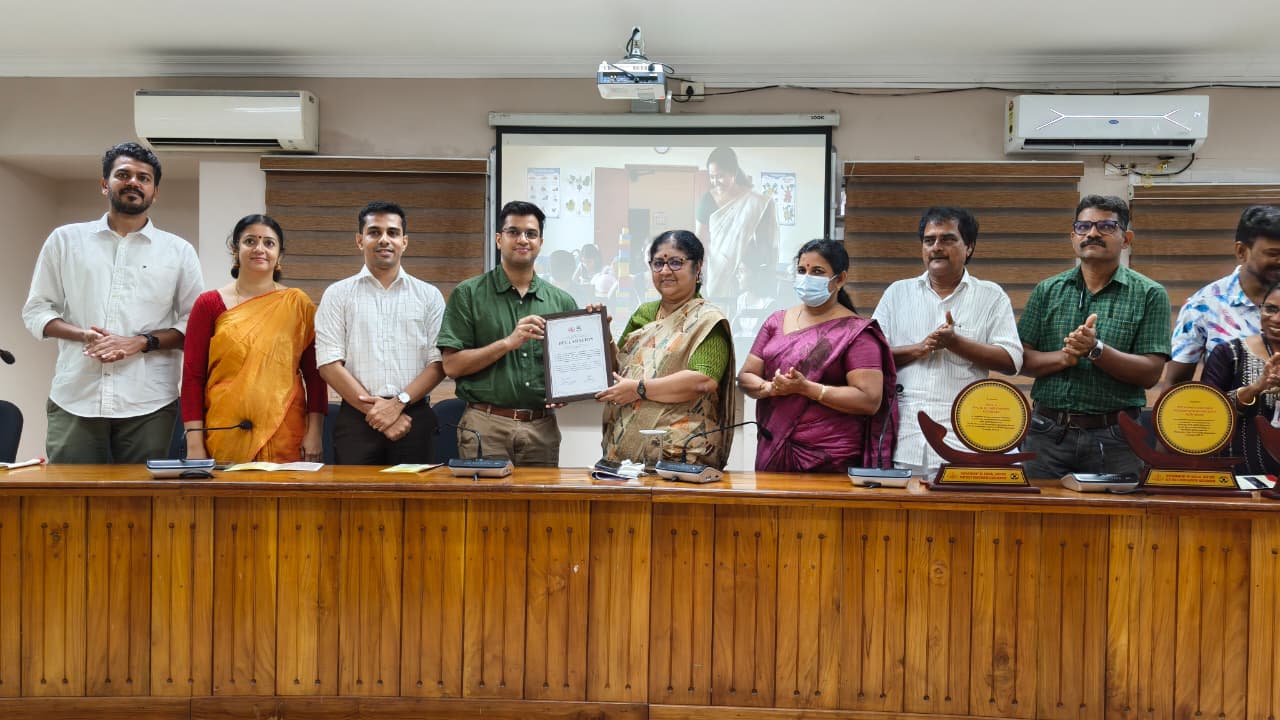Officials noted that full registration would allow beneficiaries to access welfare schemes, medical aid, and other social justice programmes more effectively.
Published Aug 25, 2025 | 12:45 PM ⚊ Updated Aug 25, 2025 | 1:02 PM

Higher Education and Social Justice Minister Dr R Bindu handing over a certificate to Kozhikode district administration officials.
Synopsis: Kozhikode became the first district in Kerala to achieve 100 percent registration under the Unique Disability ID programme. The UDID serves as a single, unified identity card that acts as the base document to access entitlements under the Rights of Persons with Disabilities Act and other welfare schemes.
Kozhikode became the first district in Kerala to achieve 100 percent registration under the Unique Disability ID (UDID) programme, bringing 57,777 differently-abled persons onto the official rolls, according to a press release by the district administration.
Announcing the milestone at a function at the Collectorate conference hall, Higher Education and Social Justice Minister Dr R Bindu lauded Kozhikode’s inclusive initiative and congratulated the teams that made it possible — from the District Collector’s office to the District Panchayat office, and the volunteers under National Service Scheme (NSS), the District Collector’s Internship Program (DCIP) and various other departments.
The UDID serves as a single, unified identity card that acts as the base document to access entitlements under the Rights of Persons with Disabilities Act and other welfare schemes.
Officials said the final leg combined 33 decentralised data-entry camps across blocks and municipalities with a mega registration drive, coordinated in Kozhikode under the district’s “Sahamitra” project as part of the state’s “Tanmudra campaign.”
With one of the largest populations of differently-abled people in Kerala, the district now tops the state’s registration efforts. A 2019 survey had listed nearly 57,000 eligible individuals, but by April 2024, only around 44,000 were registered on the Swavlamban portal. The Tanmudra drive addressed this shortfall, enrolling the remaining beneficiaries and achieving complete coverage.
“Compassionate citizenry and participative governance have always been Kozhikode’s strength. Coupled with the Collector’s leadership and the active involvement of youth in administration, these played an important role in enabling 100 percent UDID registration,” Dr Nijeesh A, Coordinator of DCIP, told South First.
Officials noted that full registration would allow beneficiaries to access welfare schemes, medical aid, and other social justice programmes more effectively.
Speaking to South First, Kozhikode District Collector Snehil Kumar Singh explained in detail how the administration accomplished the large-scale registration drive. UDID registration is done through the Government of India’s Swavlamban portal, under the Ministry of Social Justice,” he said, and added that applications can be made online or via intermediaries.
In Kerala, the process was integrated with the Tanmudra campaign, enabling both registration and medical certification for the differently abled.
He elaborated that the first step was data collection. “We gathered information through Anganwadi workers at the village level. At Anganwadis, we circulated a simple form to capture all the details needed for the Swavlamban portal,” he said.
After collecting data, the administration conducted a proof-checking exercise to verify the genuineness and correctness of applications. This verification was handled by NSS volunteers and interns of the District Collector Internship Program (DCIP), who also coordinated with colleges and community teams.
Once the data was validated, the digitisation and uploading were taken up. “The NSS volunteers and DCIP interns filed applications on behalf of those whose details we had collected. We held multiple camps across colleges, Gram Panchayats, and blocks to complete the process,” he said.
Alongside the registration, the administration organised medical camps to address certification requirements. “Sometimes disability conditions can change or old certificates may expire, so we ensured updated medical board certificates were issued when required,” the district collector added.
Speaking about the challenges, he pointed out that convincing people to come forward was the hardest task.
“Identification of beneficiaries was the toughest part. Initially, there was a lot of inertia. People were reluctant to share information, some were unaware of the UDID card, and many were unaware of its benefits. After awareness drives, we used Anganwadis and Panchayats to spread the word,” he said.
He emphasised that many differently abled persons did not voluntarily register on their own, making proactive outreach essential.
Explaining the benefits, the district collector underlined that the UDID card has become the central gateway for social entitlements.
“This is the Government of India card for availing any kind of scheme. Whether it is a pension from the Kerala government or the central government, benefits are given only after UDID registration. Even some private-sector benefits are extended only to those with a verified UDID card,” he explained.
Earlier, the medical board certificate was the only recognised document, but now the UDID makes access “much more systematic, for pensions, ration provisions, and other welfare measures.”
He further underscored why it mattered, with an example. “There have been cases where people were not even aware of UDID, and they missed out on years of pension. We wanted to resolve this by ensuring that everyone who is eligible gets what the government has promised to them,” he said.
When asked if the Kozhikode model can be replicated elsewhere, Snehil Kumar Singh was optimistic. “It is very easily replicable. We did nothing new; we just used existing systems and trained students and volunteers to handle data entry on the Swavlamban portal. With proper coordination at the district administration level, other states and districts can also achieve this quickly,” he said.
The Kozhikode model shows that transformative results can be achieved simply by using existing systems more efficiently, without creating new structures.
(Edited by Muhammed Fazil.)
